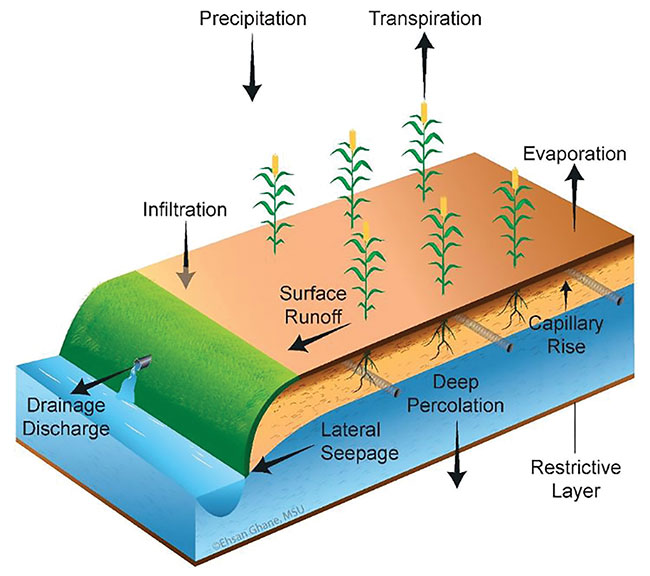
News
Drainage Management Systems
Strategies for reducing phosphorus loss
There are four key strategies to address both water quality and crop production needs.
November 7, 2023 By Ehsan Ghane, Michigan State University

Phosphorus (P) is mainly lost from subsurface-drained farms through two primary pathways of surface runoff and drainage discharge. Surface runoff mainly moves particulate P (soil-attached P) and drainage discharge mainly moves soluble P. The soil-attached P can become soluble by detaching from the soil particle. When too much P enters surface water bodies like Lake Erie and Saginaw Bay, it causes algal blooms. In this article, we discuss four strategies for reducing P loss from subsurface-drained farms.
The substantial contribution of event flows to P loss during the non-growing season calls for a system of stacked practices to reduce P loss from both surface runoff and drainage discharge. Generally, there are four strategies to address both water quality and crop production needs:
- Reduce surface runoff leaving the field by improving soil health.
- Reduce the soil test P and apply fertilizer as needed with 4R (right source, right rate, right time and right place) nutrient management.
- Reduce the amount of water leaving the field with water management.
- Capture phosphorus leaving the field with a phosphorus removal structure.
Reduce surface runoff by improving soil health
Implement minimum or no soil disturbance, permanent cover crop and diverse crop rotation. There are resources that can help you plan and implement these practices, such as One Good Idea, Soil Health Nexus and Midwest Cover Crops Council. These practices help build soil organic matter, thereby improving soil structure. The better soil structure increases infiltration and leads to a better performing tile drainage system, thereby reducing surface runoff and particulate P loss. The buildup of organic matter helps protect against drought by keeping more moisture in the soil, according to Bagnall et al. 2022.
Reduce the soil test P and apply fertilizer as needed with 4R nutrient management
Implement the 4R nutrient management approach (right source, right rate, right time and right place). Reduce the excess soil test P by performing soil testing and only applying as needed to maintain a soil test P as low as possible, according to Osmond et al. 2019. Go with subsurface placement (subsurface banding, injection) of fertilizer instead of surface broadcasting to reduce P loss. If subsurface placement is unfeasible, incorporate the fertilizer after surface broadcast. Check the weather forecast to put as much time as possible between the time of fertilizer application and rainfall.
Reduce drainage discharge with water management
Implement water management practices to reduce the drainage discharge leaving the field, thereby reducing the soluble P loss. Examples of these practices are controlled drainage, saturated buffer and drainage water recycling. Even with those conservation drainage practices, some of the water reaches the ditch. That’s where ditches are useful because they have potential to reduce P loss from the stream flow.
Controlled drainage and saturated buffers allow for water management. These two practices reduce drainage discharge by managing the outlet pipe of the drainage system. When water removal is needed for spring planting and fall harvest, these two practices allow for temporary free drainage to provide field trafficability. Drainage water recycling also allows water management by capturing drainage discharge in an on-farm reservoir, then using the water for irrigation during the growing season.
Reduce surface runoff with water management
Implement conservation practices to minimize water movement on the soil surface (that is, reduce surface runoff), thereby reducing particulate P loss. Buffer strips, terraces and grassed waterways are water management practices targeting surface runoff because they intercept the water moving on the soil surface. Reducing surface runoff reduces the loss of particulate P (soil-attached P).
Capture phosphorus with a phosphorus removal structure
Even with nutrient and water management practices, some fields can have high P loss. In that case, a P removal structure can be used to capture the excess P in drainage discharge using a P sorption material, according to Penn et al. 2020. Because event flows dominate P loss (89 percent in our study at Michigan State University Extension), P structures should be designed to capture as much P as possible from event flows.
When a P removal structure is coupled with controlled drainage, the control structure dampens the peak flow and temporarily stores water in the field, thereby treating more water and capturing more P from the large event flows. Like in a controlled drainage system, dampening the peak flow can be achieved during most of the year except for when the system needs to be under free drainage for spring planting and fall harvest. Overall, stacking of practices can reduce more P loss than a single practice alone. DC
For more information about water management and drainage, visit the MSU Extension Drainage website.
Print this page